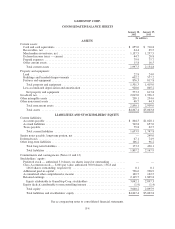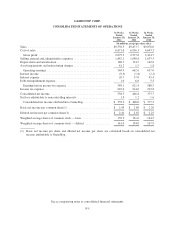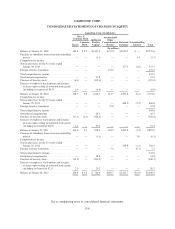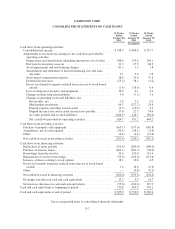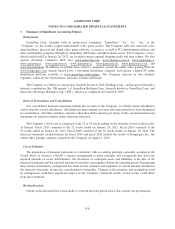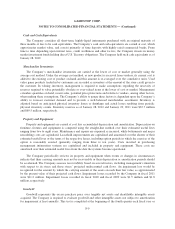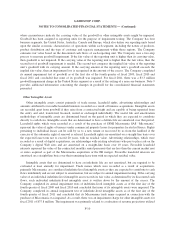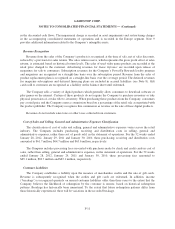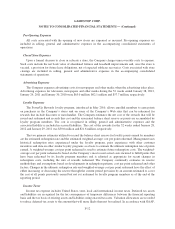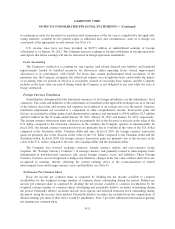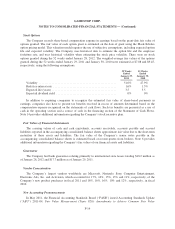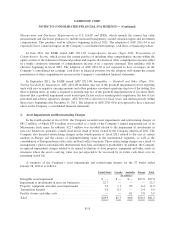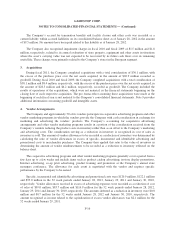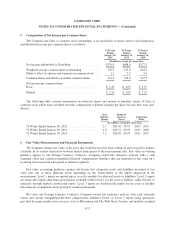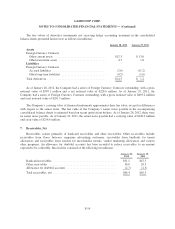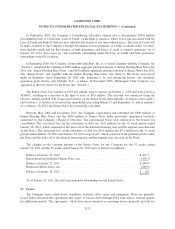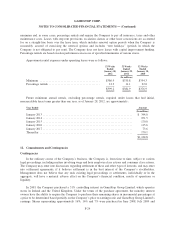GameStop 2011 Annual Report Download - page 88
Download and view the complete annual report
Please find page 88 of the 2011 GameStop annual report below. You can navigate through the pages in the report by either clicking on the pages listed below, or by using the keyword search tool below to find specific information within the annual report.
GAMESTOP CORP.
NOTES TO CONSOLIDATED FINANCIAL STATEMENTS — (Continued)
Stock Options
The Company records share-based compensation expense in earnings based on the grant-date fair value of
options granted. The fair value of each option grant is estimated on the date of grant using the Black-Scholes
option pricing model. This valuation model requires the use of subjective assumptions, including expected option
life and expected volatility. The Company uses historical data to estimate the option life and the employee
forfeiture rate, and uses historical volatility when estimating the stock price volatility. There were no stock
options granted during the 52 weeks ended January 28, 2012. The weighted-average fair values of the options
granted during the 52 weeks ended January 29, 2011 and January 30, 2010 were estimated at $7.88 and $9.45,
respectively, using the following assumptions:
52 Weeks
Ended
January 29,
2011
52 Weeks
Ended
January 30,
2010
Volatility ..................................................... 51.6% 47.9%
Risk-free interest rate ........................................... 1.6% 1.5%
Expected life (years) ............................................ 3.5 3.5
Expected dividend yield ......................................... 0% 0%
In addition to requiring companies to recognize the estimated fair value of share-based payments in
earnings, companies also have to present tax benefits received in excess of amounts determined based on the
compensation expense recognized on the statements of cash flows. Such tax benefits are presented as a use of
cash in the operating section and a source of cash in the financing section of the Statement of Cash Flows.
Note 14 provides additional information regarding the Company’s stock incentive plan.
Fair Values of Financial Instruments
The carrying values of cash and cash equivalents, accounts receivable, accounts payable and accrued
liabilities reported in the accompanying consolidated balance sheets approximate fair value due to the short-term
maturities of these assets and liabilities. The fair value of the Company’s senior notes payable in the
accompanying consolidated balance sheets is estimated based on recent quotes from brokers. Note 6 provides
additional information regarding the Company’s fair values of our financial assets and liabilities.
Guarantees
The Company had bank guarantees relating primarily to international store leases totaling $18.2 million as
of January 28, 2012 and $17.7 million as of January 29, 2011.
Vendor Concentration
The Company’s largest vendors worldwide are Microsoft, Nintendo, Sony Computer Entertainment,
Electronic Arts, Inc. and Activision, which accounted for 17%, 16%, 15%, 13% and 11%, respectively, of the
Company’s new product purchases in fiscal 2011 and 18%, 16%, 16%, 10% and 12%, respectively, in fiscal
2010.
New Accounting Pronouncements
In May 2011, the Financial Accounting Standards Board (“FASB”) issued Accounting Standards Update
(“ASU”) 2011-04, Fair Value Measurement (Topic 820): Amendments to Achieve Common Fair Value
F-14


